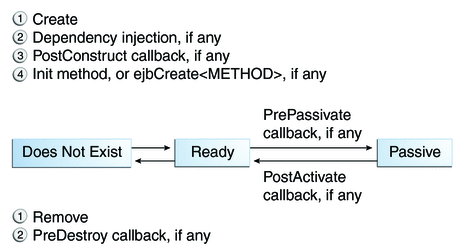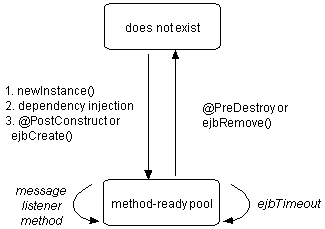Circumstances Under Which a Message Driven Bean Should Be Used
Bean instance pools are used for Stateless Session Beans SLSBs and Message Driven Beans MDBs. The message is cast as a JMS message which is handled based on.

Message Driven Bean Javatpoint
This clearly indicates that persistent messages are always delivered to the destination.

. A Message-Driven Bean Example Introduction. In general JMS messages should not be sent or received synchronously. Message Beans have guaranteed delivery once a message is on a queue Assuming the queue is persistent it is persisted and even in case of a crash upon startup the MessageBean will process it.
A message driven bean is a type of enterprise bean which is invoked by EJB container when it receives a message from queue or topic. To receive messages asynchronously use a message-driven bean. A message-driven bean is an endeavor bean that permits Java Enterproses Entity applications to process messages non-concurrently.
They are basically classified based on priority. By default SLSBs use the instance pool default-slsb-instance-pool and MDBs use the instance pool default-mdb-instance-pool. Description of a Message-driven Bean A Message-driven Bean is an EJB component that can be considered as a JMS MessageListener ie processing JMS messages asynchronously.
Note that each endpoint that is concurrently processing a message request adds at least two times the message size to the server JVM heap and can add more especially if a two. When to Use Message-Driven Beans Session beans and entity beans allow you to send JMS messages and to receive them synchronously but not asynchronously. Assume that the student table is created in database.
Others are non-persistent messages. Bean instance pools are used for Stateless Session Beans SLSBs and Message Driven Beans MDBs. The execution of JobBeans is handled by the EJB container.
The Message-driven bean can only use the Migratable Service when they are on clustered servers At this time the Migratable Service cannot span multiple clusters. When you deploy a message-driven bean that processes messages concurrently estimate the potential consumption of the application server memory by concurrent endpoints. To avoid tying up server resources you may prefer not to use blocking synchronous receives in a server-side component.
If WebLogic Server does not migrate the message-driven bean along with the JMS Server to an available server in the cluster the JMS destination will be flooded with messages. Session beans allow you to send JMS messages and to receive them synchronously but not asynchronously. As a rule of thumb you should use MDBs only if you require asynchronous processing loose-coupling and reliability.
Message-driven beans are used in asynchronous communication between enterprise application components. Jobs are implemented on the basis of message-driven beans. To receive messages asynchronously use a message-driven bean.
Student- ID student-name program semester student address using JDBC. In WebSphere MQ two types of messages exist. Therefore MDBs allow us to decouple our applications into smaller services with localized responsibilities allowing a much more modular and incremental system that can recover from system failures.
In cluster environment the JMS is responsible. The messages which are urgent and should be recovered in all the circumstances are called persistent messages. The and part in.
To avoid tying up server resources do not to use blocking synchronous receives in a server-side component. In the case of asynchronous Session Beans in case of a crash you have lost your message unless you handle this yourself. The trouble is that component interfaces are just a needless abstraction in a lot of circumstances.
To receive messages asynchronously a Message-driven bean is used. What makes message driven beans different from session beans. In fact at least one interface is required even for EJB 30 Session Beans this is not a requirement for EJB 30 Message Driven Beans.
Briefly explain any seven JSP implicit objects. In either case a message-driven bean does not receive a transaction context from the client that sends a message. By default SLSBs use the instance pool default-slsb-instance-pool and MDBs use the instance pool default-mdb-instance-pool.
Explain the various circumstances under which a message-driven bean should be used. That is precisely why both EJB 21 and Spring promote the idea of component interfaces. During activation of a message-driven bean no suitable active messaging engines were found in the local server on the bus 0.
The size of a bean instance pool limits the number of instances of a particular EJB that can be created at one time. As always the code is over on GitHub. A JobBean is executed when it receives a Java Messaging Service JMS message from the scheduler runtime service.
When a new message arrives the enterprise JavaBeans container calls the message-driven beans onMessage method to process the message. A message-driven bean containing a job is called a JobBean. Write a code in JSP to insert records in a student table with fields.
When the messaging engines start another information message confirms this and message handling can then occur. Messaging and message-driven beans are powerful concepts but they are not right for every use-case. As with other EJB types message-driven beans can demarcate transaction boundaries either on their own using bean-managed transactions or by having the WebLogic Server container manage transactions container-managed transactions.
It implements the onMessagejavaxjmsMessage method defined in the javaxjmsMessageListener interface. Explain various circumstances under which a message driven bean should be used. Message Driven Beans allow simple creation of a queue based application.
To demonstrate use of message driven bean we will make use of EJB-persistence chapter and we need to do the following tasks. The size of a bean instance pool limits the number of instances of a particular EJB that can be created at one time. What is the purpose of message-driven beans and define its structure.
Message driven beans are the light weight components used for communication via messages eg email or IM messages. Message driven bean is a stateless bean and is used to do task asynchronously. It typically goes about as a Java Message Services message audience which is like an occasion audience aside from that it gets.
It is associated with a JMS destination ie a Queue for. Session beans allow you to send JMS messages and to receive them synchronously but not asynchronously. A message is processed as follows.



0 Response to "Circumstances Under Which a Message Driven Bean Should Be Used"
Post a Comment